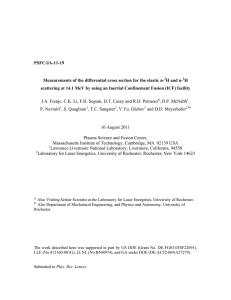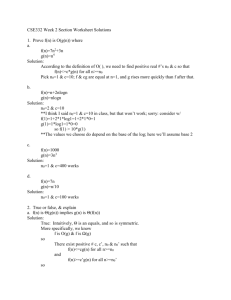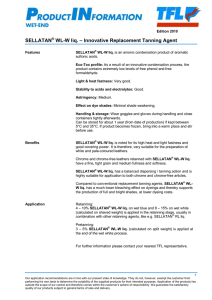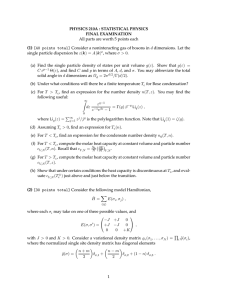Measurements of the Differential Cross Sections for the
advertisement
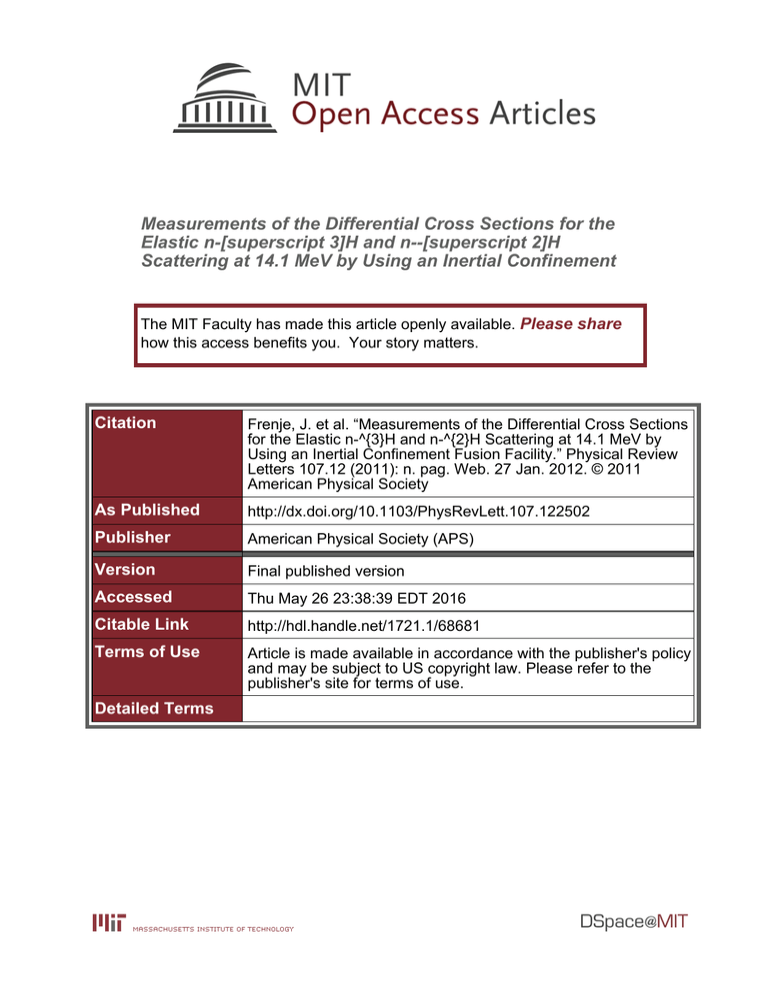
Measurements of the Differential Cross Sections for the
Elastic n-[superscript 3]H and n--[superscript 2]H
Scattering at 14.1 MeV by Using an Inertial Confinement
The MIT Faculty has made this article openly available. Please share
how this access benefits you. Your story matters.
Citation
Frenje, J. et al. “Measurements of the Differential Cross Sections
for the Elastic n-^{3}H and n-^{2}H Scattering at 14.1 MeV by
Using an Inertial Confinement Fusion Facility.” Physical Review
Letters 107.12 (2011): n. pag. Web. 27 Jan. 2012. © 2011
American Physical Society
As Published
http://dx.doi.org/10.1103/PhysRevLett.107.122502
Publisher
American Physical Society (APS)
Version
Final published version
Accessed
Thu May 26 23:38:39 EDT 2016
Citable Link
http://hdl.handle.net/1721.1/68681
Terms of Use
Article is made available in accordance with the publisher's policy
and may be subject to US copyright law. Please refer to the
publisher's site for terms of use.
Detailed Terms
week ending
16 SEPTEMBER 2011
PHYSICAL REVIEW LETTERS
PRL 107, 122502 (2011)
Measurements of the Differential Cross Sections for the Elastic n-3 H and n-2 H Scattering
at 14.1 MeV by Using an Inertial Confinement Fusion Facility
J. A. Frenje, C. K. Li, F. H. Seguin, D. T. Casey, and R. D. Petrasso
Plasma Science and Fusion Center, Massachusetts Institute of Technology, Cambridge, Massachusetts 02139, USA
D. P. McNabb, P. Navratil, and S. Quaglioni
Lawrence Livermore National Laboratory, Livermore, California 94550, USA
T. C. Sangster, V. Yu Glebov, and D. D. Meyerhofer*
Laboratory for Laser Energetics, University of Rochester, Rochester, New York 14623, USA
(Received 18 June 2011; published 15 September 2011)
For the first time the differential cross section for the elastic neutron-triton (n-3 H) and neutron-deuteron
(n-2 H) scattering at 14.1 MeV has been measured by using an inertial confinement fusion facility. In these
experiments, which were carried out by simultaneously measuring elastically scattered 3 H and 2 H ions
from a deuterium-tritium gas-filled inertial confinement fusion capsule implosion, the differential cross
section for the elastic n-3 H scattering was obtained with significantly higher accuracy than achieved in
previous accelerator experiments. The results compare well with calculations that combine the resonatinggroup method with an ab initio no-core shell model, which demonstrate that recent advances in ab initio
theory can provide an accurate description of light-ion reactions.
DOI: 10.1103/PhysRevLett.107.122502
PACS numbers: 25.40.Dn, 52.57.z
The development of an accurate description of light-ion
reactions is currently of great interest as it would provide
valuable insight into low-energy nuclear reactions important to nuclear astrophysics. Radiative capture reactions, for
example, occur in red giants at temperatures low enough
that the reaction rates are too small to be directly measured
in a laboratory. Extrapolation from measurements at higher
energies is also suspect without a fundamental theory for
computing these reactions. Fusion energy research also
requires accurate cross sections for light-ion reactions to
constrain models of inertial confinement fusion (ICF) experiments involving deuterium-tritium fuel. For instance,
uncertainties in the differential cross section for the elastic
n-3 H scattering need to be 5% to reliably infer a fuel areal
density (R) from the yield ratio between scattered
neutrons and primary 14.1-MeV neutrons, called the
down-scatter ratio [1], produced in an ICF implosion. The
determination of the R from the down-scatter ratio value is
essential for understanding how the fuel is assembled in an
implosion and for ultimately guiding the community towards the demonstration of thermonuclear ignition and net
energy gain [2] at the National Ignition Facility [3].
Since the 1950s, the differential cross section for the
elastic n-3 H scattering at 14.1 MeV has been subject to
both experimental and theoretical studies. Kootsey [4]
measured the cross section at center-of-mass (CM) angles
ranging from 55 to 165 , resulting in data with statistical
uncertainties of 20% and a systematic uncertainty of
11%. Shirato et al. [5] and Debertin et al. [6] measured
the cross section in the CM angular range of 100 –175
with an uncertainty varying from 10% to 70%, and
0031-9007=11=107(12)=122502(5)
their results are in good agreement with each other but up
to a factor of 2 smaller than the Kootsey data. Opticalmodel calculations conducted by DeVries et al. [7] and by
Sherif and Podmore [8] reproduced the Shirato and
Debertin data in this CM angular range. Additionally,
Hale et al. [9] conducted an R-matrix analysis of all
experimental data sets, and the result from that analysis
forms the basis of the current ENDF/B-VII evaluation [10]
of the differential cross section for the elastic n-3 H scattering that can be found in nuclear databases. Although
efforts have been made to quantify this fundamental cross
section, significant discrepancies exist between the different measurements and between measurements and models.
However, a theoretical understanding of the n þ 3 H scattering based on first principles calculations is within reach
[11]. For example, ab initio variational calculations using a
hyper-spherical harmonics basis expansion performed with
a modern nuclear Hamiltonian consisting of an accurate
nucleon-nucleon potential and a three-nucleon interaction
provide a good description of the differential cross section
for elastic n þ 3 H scattering at low energies [12]. However,
this type of calculation is currently limited to energies
below the breakup threshold.
This Letter describes the first measurement of the differential cross section for the elastic n-3 H scattering at
14.1 MeV by using an ICF facility. It also describes a
theoretical calculation [13] of this cross section, which
combines the ab initio no-core shell model [14] with the
resonating-group method [15] into a unified method
(NCSM/RGM) [16]. By using this theoretical approach,
an accurate assessment of the n-3 H cross section can be
122502-1
Ó 2011 American Physical Society
PRL 107, 122502 (2011)
week ending
16 SEPTEMBER 2011
PHYSICAL REVIEW LETTERS
made from precision data taken for the isobaric analogue
p-3 He reaction. In these experiments, which were carried
out on the OMEGA laser [17], deuterium-tritium-gas-filled
thin-glass capsules were used. Each capsule, made of
SiO2 , had a diameter of about 850 m, a gas-fill pressure
of about 20 atm, and a shell thickness of 3:5 m. The fuelgas mixture was 48:2% 0:3% deuterium, 48:8% 0:3%
tritium, 2.5% hydrogen, and 0.5% helium 3 from the
tritium decay. These capsules were imploded by 60 laser
beams that uniformly delivered 30 kJ to the capsule in a
1-ns square pulse. As the laser energy is quickly absorbed
by the glass, the outer part of the glass shell explodes
outward while the remaining part moves inward. The
imploding part of the shell acts a piston and drives a shock
through the deuterium-tritium fuel that heats the ions. The
glass shell continues to move inward behind the shock
front, isentropically compressing the postshock region of
the fuel, and additionally heats the ions to thermonuclear
temperatures. Each implosion, which acts as both a 14.1MeV neutron source and deuterium-tritium target, produced a burn-averaged ion temperature of 8:5 0:5 keV
and a neutron yield of about 4 1013 , which were measured with a neutron time-of-flight diagnostic [18]. The
energy spectra of the emitted tritons and deuterons, elastically scattered by the 14.1-MeV neutrons, were measured
simultaneously by using a magnet-based charged-particle
spectrometer (CPS) [19] installed on the OMEGA chamber
(Fig. 1). To cover the energy range of interest in this
experiment, the detector plane of the CPS was comprised
of two pieces of CR-39, which is a plastic polymer that is
insensitive to rays and x rays produced in an implosion
[19]. Different particle track characteristics in CR-39 allow
the CPS to make simultaneous measurements of the scattered deuterons (d0 ) and tritons (t0 ) with energies greater
than 3:7 and 2:5 MeV, respectively (the lower energy
limits are set by the width and position of the CR-39 piece).
A measurement of the proton spectrum from dd reactions
was conducted as well to check that the emitted charged
particles were not subject to any significant energy losses
in the plasma.
d0 and t0 spectra measured simultaneously on three
different OMEGA shots are shown in Figs. 2(a)–2(c).
These spectra, which have been background subtracted,
were obtained by putting constraints on the diameter and
darkness of the observed ion tracks in the CR-39 (the
triton, deuteron, and background tracks have different
characteristics that were used for the differentiation [19]).
The remaining background that could not be rejected was
characterized from regions on the CR-39 where d0 and t0
signals cannot be detected. The error bars shown in the
spectra are statistical uncertainties associated with the
number of signal and background counts in each energy
bin. The dd-proton spectrum measured for shot 31753
[Fig. 2(d)] displays an average energy that is similar to
the birth energy of 3.05 MeV (temperature corrected),
(a)
CPS
OMEGA
chamber
(b)
Implosion
Magnet
0.05
0.2
0.6
45
1.0
[MeV]
3.0
10
CR-39
FIG. 1 (color). (a) The CPS on the OMEGA chamber for
simultaneous measurements of deuterons and tritons elastically
scattered by 14.1-MeV neutrons, and protons from dd reactions
in a deuterium-tritium-gas-filled thin-glass capsule implosion. A
bending magnet (gray) was used for momentum analysis.
(b) Schematic drawing of the CPS, which uses a 2-mm wide
aperture in front of a 7.6-kG permanent magnet (Nd-Fe-B) for
dispersion and high-resolution measurements of the charged
particles. Two pieces of CR-39 were used for detection of the
dd protons and the elastically scattered deuterons and tritons.
The energies are given in MeV for protons.
indicating that energy losses in the plasma are negligible.
From the measured d0 and t0 spectra, the differential cross
section for the elastic n-3 H and n-2 H scattering was determined by deconvolving the CPS-spectrometer response
[20] and the Doppler-broadened 14.1-MeV-neutron spectrum [21]. In the determination of the n-2 H cross section,
the effect of the deuterons from the tðn; 2nÞd reaction was
considered and accounted for. Here, it was assumed that
the cross section for this reaction is 6 4 mb, which
covers the reported value in Ref. [22], or about 3% 2%
of the total deuteron spectrum in the range 3.7–7.3 MeV.
Additionally, as the plasma had a burn-averaged ion temperature of 8.5 keV, a density of 1 g=cm3 , and a total
areal density of 2–3 mg=cm2 , energy-loss effects were
insignificant and thus not considered. From an energy-loss
point of view, these plasma conditions correspond to a cold
target with an areal density less than 0:3 mg=cm2 .
Figures 3(a) and 3(b) show the differential cross section
for the elastic n-2 H and n-3 H scattering measured in this
work. These cross sections, which are compared to the
122502-2
PHYSICAL REVIEW LETTERS
PRL 107, 122502 (2011)
2
(×10 )
Shot 31752
Counts / bin
Counts / bin
4
3
t' d'
2
1
0
0
5
15
t' d'
Shot 31769
10
15
(×10 )
150
Shot 31753
Counts / bin
Counts / bin
4
t' d'
2
100
0
0
0
5
10
MeV
15
Debertin (1967)
Kootsey (1968)
Shirato (1976)
This work
50
5
1
0
(b)
100
0
5
(d)
3
Allred (1953)
Seagrave (1955)
Bruellmann (1968)
Shirato (1972)
Schwarz (1983)
This work
50
3
10
(a)
150
MeV
(×10 )
(c)
Shot 31753
MeV
2
5
10
7 (b)
6
5
4
3
2
1
0
0
mb/sr
(a)
200
2
(×10 )
mb/sr
5
week ending
16 SEPTEMBER 2011
0
1
2
3
MeV
4
45
90
135 180
CM angle [Degrees]
5
FIG. 2 (color). (a)–(c) d0 and t0 spectra measured simultaneously on three different OMEGA shots. The broadening of
these spectra is due to the Doppler-effect and CPS-spectrometer
response. (d) dd-proton spectrum measured for shot 31753
illustrates that the average energy is similar to the birth energy
of 3.05 MeV.
FIG. 3 (color). (a) Measured differential cross section for the
elastic n-2 H scattering, which has been normalized to a Faddeev
calculation. (b) Measured and calculated differential cross section for the elastic n-3 H scattering. The experimental data have
been normalized with the deuterium-tritium fuel-ratio modified
normalization factor derived in (a). The blue solid curve represents an ab initio NCSM/RGM calculation, and the red dashed
curve represents an R-matrix calculated n-3 H cross section.
other data sets, are averages of the three measurements
shown in Figs. 2(a)–2(c). The n-2 H cross section determined for each shot was normalized to a Faddeev calculation that is accurate to about 1%, and that normalization
factor, modified by the deuterium-tritium fuel ratio, was
subsequently applied to the measured n-3 H cross section
for the same shot (the Faddeev calculation was obtained
with the next-to-next-to-leading-order nucleon-nucleon
plus three-nucleon interaction chiral force of Ref. [23]).
As illustrated by Fig. 3(a), the angular variation of the
measured n-2 H elastic cross section is in good agreement
with the Faddeev calculated cross section, indicating that
the background subtraction, the characterization of the
response function, and the effect of the Doppler broadening are accurate and that the deconvolution process
provides high-fidelity data. The uncertainties shown for
the n-3 H cross section [shown in Fig. 3(b) and Table I]
are based on the statistical uncertainty and the uncertainty
associated with the normalization factor. As the total n-2 H
elastic cross section and the deuterium-tritium-fuel ratio in
these experiments have an uncertainty of 1.0% and 0.9%,
respectively, the uncertainty in the normalization factor is
estimated to be 1.4%. This results in a total uncertainty
ranging from 4% to 7% in the CM-angle range of 60 –80 ,
which is the most important range for diagnosing ICF
implosions over which the n-3 H cross section dominates
the other ICF-relevant cross sections. This uncertainty
should be contrasted to the total uncertainty larger than
20% for the Kootsey data, which is the only other data set
in this angular range. Considering the uncertainties involved, the experimentally determined n-3 H cross section
compares well with the current ENDF/B-VII evaluated
cross section, which is based on Hale’s R-matrix analysis
of accurate p-3 He data in a wide range of energies. The fit
parameters obtained in that analysis were then adjusted to
account for the Coulomb effects, as explained in Ref. [9],
and subsequently applied to the n-3 H reaction. The results
from the R-matrix analysis are shown by the red dashed
curve in Fig. 3(b). Another theoretical approach, described
in detail in Ref. [16], was recently developed for evaluating
the cross sections of light-ion reactions. This NCSM/RGM
approach, unlike earlier ab initio approaches, allows calculations of various nucleon-nucleus scattering processes
for systems with A > 4, i.e., on both s- and p-shell nuclei
[13,16]. The present NCSM/RGM calculations for the
n-3 H and p-3 He systems use a similarity-renormalization-group-evolved chiral N3 LO nucleon-nucleon interaction that includes Coulomb and other isospin breaking
terms [24]. A less than 15% inaccuracy in these calculations at forward angles is introduced by limiting the model
space to channel states with the three-nucleon system in its
ground state. To quantify and correct for this inaccuracy,
122502-3
PHYSICAL REVIEW LETTERS
PRL 107, 122502 (2011)
TABLE I. Measured and calculated differential cross section
for the elastic n-3 H scattering as a function of the CM angle at
14.1 MeV. The NCSM/RGM calculation, which is corrected at
forward angles as explained in the text, is considered to be
accurate to about 5%.
CM angle
[degrees]
Measured
[mb/sr]
Error
[mb/sr]
NCSM/RGM
[mb/sr]
58.6
61.2
63.7
66.1
68.3
70.5
72.6
74.7
76.8
79.0
81.2
83.4
85.7
87.9
90.3
92.6
94.8
97.1
99.3
101.5
103.6
105.7
107.8
110.0
112.2
114.4
116.8
119.4
122.0
124.8
127.7
130.7
133.7
136.8
139.8
142.9
146.3
150.2
155.2
162.2
172.3
116.7
106.6
94.7
88.8
81.6
75.0
67.8
60.3
53.4
48.1
44.0
37.1
31.5
29.4
26.3
21.7
17.5
15.7
11.9
10.2
11.3
11.2
7.4
7.8
7.6
7.5
8.5
8.5
9.6
12.0
14.4
15.5
21.2
26.5
29.9
37.2
45.6
46.5
61.4
70.5
79.4
4.4
3.3
3.5
3.6
3.7
3.9
3.7
3.6
3.5
3.2
3.2
3.3
3.1
2.8
2.9
2.9
2.7
2.5
2.4
2.5
3.3
2.2
1.9
1.9
1.8
1.6
1.3
1.3
1.3
1.2
1.4
1.3
1.4
1.7
1.8
2.2
2.7
3.4
4.7
6.0
7.7
119.3
109.9
101.11
93.1
85.6
78.7
72.1
65.9
59.9
54.1
48.5
43.2
38.2
33.4
29.1
25.1
21.6
18.5
15.9
13.7
11.8
10.4
9.2
8.4
8.0
7.9
8.1
8.9
10.2
12.1
14.6
17.7
21.5
25.8
30.5
35.9
42.1
49.4
59.1
71.6
84.3
high-precision p-3 He data [25] is compared to the corresponding NCSM/RGM results, and the obtained correction
function is applied to the n-3 H calculation. The result of
this procedure, which is accurate to 5%, is illustrated by
the blue solid curve in Fig. 3(b), which is also in good
week ending
16 SEPTEMBER 2011
agreement with our experimental data but differs from the
R-matrix analysis by a couple percent in the backward
scattering angles of the outgoing neutron. Considering
the estimated uncertainty of 5% for the NCSM/RGM
calculation, this discrepancy is, however, insignificant.
Additional details of the n-3 H and p-3 He NCSM/RGM
calculations are found in Ref. [13].
In summary, we report on the first measurements of the
differential cross section for the elastic n-3 H and n-2 H
scattering at 14.1 MeV by using an ICF facility. The
resulting n-3 H data are of higher quality than achieved in
previous accelerator experiments reported in the literature
and accurate enough to reliably determine the fuel R from
the yield ratio between scattered neutrons and primary
14.1-MeV neutrons produced in an ICF implosion. The
experimental results obtained at CM angles ranging from
59 to 172 are in good agreement with a theory that is
based on isospin corrected ab initio calculations of the
isobaric analogue p þ 3 He reaction. Both measured and
calculated cross sections compare well with the current
ENDF/B-VII evaluated cross section, which is based on
Hale’s R-matrix analysis. A total n-3 H elastic cross section
of 941 47 mb was calculated by using the NCSM/RGM
method.
The authors thank Dr. Evgeny Epelbaum for providing
Faddeev calculations of n-2 H scattering at 14.1 MeV,
which provided the basis for normalizing these experimental results. The work described here was supported in part
by NLUF (DOE Grant No. NA0000877), FSC (Rochester
Subaward PO No. 415023-G, UR Account No. 5-24431),
U.S. DOE (Grant No. DE-FG03-03SF22691), LLE (Grant
No. 412160-001G), LLNL (Grant No. B504974), and GA
under DOE (Grant No. DE-AC52-06NA27279).
*Also Department of Mechanical Engineering, and Physics
and Astronomy, University of Rochester.
[1] J. A. Frenje et al., Phys. Plasmas 17, 056311 (2010).
[2] B. K. Spears et al., Phys. Plasmas (to be published).
[3] G. H. Miller et al., Nucl. Fusion 44, S228 (2004).
[4] J. M. Kootsey, Nucl. Phys. A113, 65 (1968).
[5] S. Shirato et al., Nucl. Phys. A267, 157 (1976).
[6] W. Debertin et al., EXFOR database, National Nuclear
Data Center, Brookhaven, 1967.
[7] R. M. DeVries et al., Nucl. Phys. A188, 449 (1972).
[8] H. S. Sherif and B. S. Podmore, in Few Particle Problems
in Nuclear Interaction, edited by I. Slaus et al. (NorthHolland, Amsterdam, 1972), p. 691.
[9] G. M. Hale, D. C. Dodder, J. D. Seagrave, B. L. Berman,
T. W. Phillips, Phys. Rev. C 42, 438 (1990).
[10] M. B. Chadwick et al., Nuclear Data Sheets 107, 2931
(2006).
[11] R. Lazauskas et al., Phys. Rev. C 71, 034004 (2005).
[12] M. Viviani et al., Few-Body Syst. 45, 119 (2009).
[13] P. Navrátil et al., arXiv:1009.3965; P. Navratil, S.
Quaglioni, J. D. Anderson, F. S. Dietrich, D. P. McNabb,
122502-4
PRL 107, 122502 (2011)
[14]
[15]
[16]
[17]
[18]
[19]
[20]
PHYSICAL REVIEW LETTERS
and G. Hale, Lawrence Livermore National Laboratory
Report No. LLNL-TR-423504, 2010.
P. Navrátil, J. P. Vary, and B. R. Barrett, Phys. Rev. Lett.
84, 5728 (2000); Phys. Rev. C 62, 054311 (2000).
K. Wildermuth and Y. C. Tang, A Unified Theory of the
Nucleus (Vieweg, Braunschweig, 1977).
S. Quaglioni and P. Navratil, Phys. Rev. Lett. 101, 092501
(2008); Phys. Rev. C 79, 044606 (2009).
T. R. Boehly et al., Opt. Commun. 133, 495 (1997).
V. Yu. Glebov et al., Rev. Sci. Instrum. 75, 3559 (2004).
F. H. Séguin et al., Rev. Sci. Instrum. 74, 975 (2003).
The CPS-spectrometer response is described by a 300 and
1000 keV rectangular distribution at 5 and 10 MeV, re-
[21]
[22]
[23]
[24]
[25]
122502-5
week ending
16 SEPTEMBER 2011
spectively. For an 8.5-keV plasma the Doppler-broadened
dt-neutron spectrum is described by a Gaussian distribution with a width of 520 keV (FWHM) [21].
H. Brysk, Plasma Phys. 15, 611 (1973).
I. J. Thompson, Comput. Phys. Rep. 7, 167 (1988).
E. Epelbaum et al., Phys. Rev. C 66, 064001
(2002).
S. K. Bogner, R. J. Furnstahl, and R. J. Perry, Phys. Rev. C
75, 061001 (2007); D. R. Entem and R. Machleidt, Phys.
Rev. C 68, 041001(R) (2003).
R. L. Hutson, Nelson Jarmie, J. L. Detch, Jr., and J. H. Jett,
Phys. Rev. C 4, 17 (1971).
